|
This is a specialized version of the venerable and famous 88mm Flak gun. Briga identifies the kit as a bunker busting gun.
According to [2], three schwere Panzer-Jäger-Abteilungen (525, 560 & 605) were outfitted with these guns in the
anti-tank role during the 1940 French Campaign. In any case, its use as an anti-tank gun as well as a bunker buster seems quite reasonable.
The conversion from a dual purpose gun to a dedicated ground support gun entailed the replacement of the
left mounted fuse setter with a box containing 6 ready rounds along with a platform for the loader behind the box. The seat for the elevation layer was deleted and
on the right side the gun layer controlled the aim with a hand wheels, one operating the traversing gear, and the other operating the elevation gears employing an
endless chain. The shield was replaced with a much larger version to protect the crew and the two folding legs were replaced with specially designed spars and pads
to allow the gun to be fired at any angle directly from the trailer. All my reference photos show the gun being fired from the trailer though I suspect that it
may have been used dismounted from the trailer as well.
The kit
With the 1940 time frame and the Sonderanhänger 201 trailer, this gun was based on the 8.8cm Flak 18.
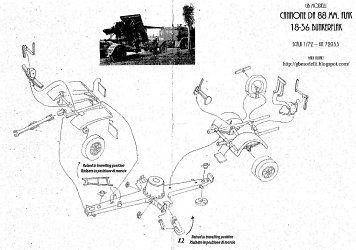
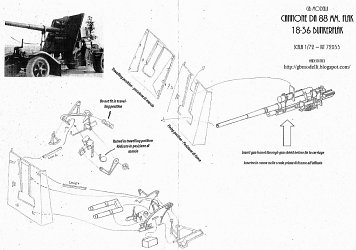
Instructions are vague regarding part placement and the diagrams are faint and hard to read. I had to adjust the gamma correction and contrast to get the above
scanned images dark enough to be readable. The two reference pictures provided to give the builder additional guidance are dark and grainy. No marking or colouring
information is provided, though my guess is that overall panzer grey would be the only realistic option. References [1] & [2] only have a few clear pictures of
this gun which I have added below to help those needing clearer photos to help with the build.
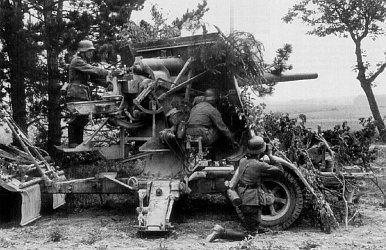
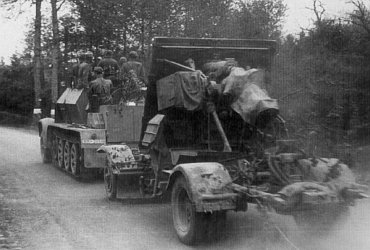
The kit appears to be an amalgam of parts cast from the Hasegawa kit, along with a few from the Revell kit, plus some completely new items for the specific changes
for this gun.
From the Hasegawa kit we get copies of the cross Lafette (with some minor modifications), wheels, carriage (with some modifications to improve it over the base Hasegawa part) and a few
smaller items like seats and aiming wheels.
From the Revell kit we get copies of the trunnion mount, equilibrators and gun tube/slide.
The new items cover the specific changes for this gun - two shields (one for travel position & one for firing position), loader's platform with ready ammo bin,
outriggers, and a few other small items.
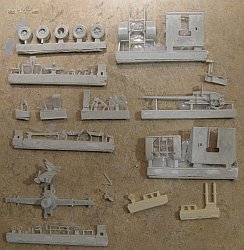
A lot of the parts were broken, which is not unusual with fine resin castings. This may also have been due to the fact that the kit was shipped twice - once to our
primary OTW receiver, and thence to me. Resin is very brittle and breaks easily. Some wafer thin flash is present that should be
easy to remove. Pin holes are few but are fairly large and found in awkward places. A lot of the larger parts are warped - gun barrel, carriage and Lafette.
For some reason the twin wheels were cast as a single part. It would have been nicer with them being separate. Overall detail is somewhat soft in places.
I did not like the Lafette casting and its underside is gruesome (see photo third from the top).
Its upper and side surfaces, as well as those of a lot of the other parts, have a rough texture (for example the tube frame of the trailer bogies), which would look
not too bad if they were representing a cast metal part for something like a turret, but for items that were rolled steel a smoother finish would be more
appropriate.
(You can see the roughness of the resin in the sheen on the laffette's upper surface, as well as the warped legs of the Lafette in the top picture at right.)
|

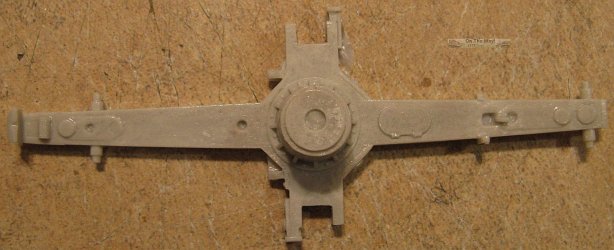

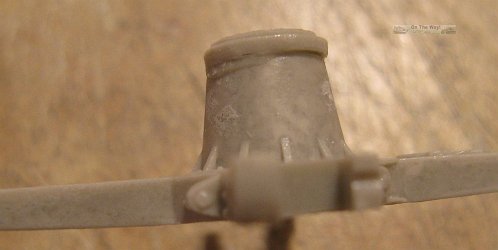
|
Most period photos do not show the spare wheel attached to the right rear fender so this could be omitted if desired.
The firing position shield is well done, and is huge compared to the standard shield of the Flak version. The shield for travel with the side wings folded inward
onto the face of the shield is not as well done. Having separate wings would make it look much nicer. In the photo below you can see the GB Modelli shield (firing position version) on the left,
the two Revell shields stacked one above the other in the middle, and the Hasegawa shield to the right. I also really like the continuous chain for the gunner's position
and the new outrigger parts.
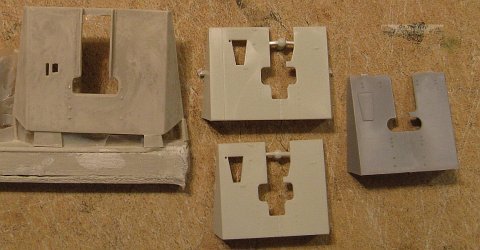
Conclusion
Unfortunately this is not a kit I can recommend. Previous GB Modelli kits I've seen have been decent, not up to the level of the better manufacturers for sure, but buildable. This one falls
well short of that. The warped parts, rough castings and softish detail make this kit one that I personally would only use as a parts donor, or for templates to make
my own parts in building a nicer conversion of
the Hasegawa and Revell kits into this specialized variant of this famous gun.
Post-preview comment from Giorgio Briga:
The sample sent was pre-production. The kit now includes a better instruction sheet and some of the warped moldings have been corrected, although there is
still the chance that some part warping may still be present due to the nature of resin.
There are also good photos of this gun to be found on the GB Modelli blog
here.
References
[1] 88mm Flak in the First and Second World Wars, Werner Müller, Schiffer Military History, Atglen 1998 ISBN: 0-7643-0393-7
[2] Dreaded Threat: The 8.8cm Flak18/36/37 in the Anti-tank Role, Thomas L. Jentz, Panzer Tracts, Boyd 2001 ISBN: 0-9708407-0-5
Preview sample supplied by Giorgio Briga of GB Modelli.
Briga (GB Modelli) products
are available at

|